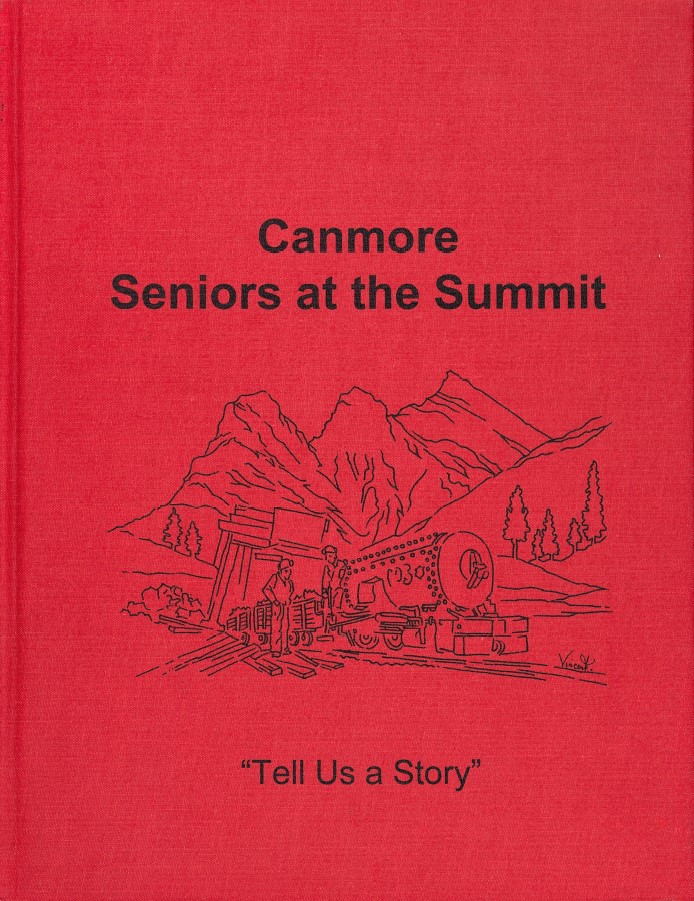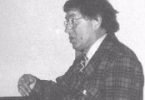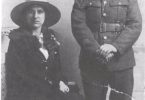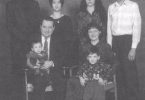I was born about six miles out of Cabri, Sask. on a farm on November 6, 1918. My parents were Oscar and Aagot (Sondrol). I was the third child out of eight. Cabri is about forty five miles from Swift Current. I attended school at Cabri, in winter travelling with horse and school van (cutter with a house over it). Then we moved to Morse, Sask., then to Calgary. We lived in a tent along the Bow River across from Montgomery. In winter we had a small house. Then my dad got a job at the plant at Exshaw: he was a blacksmith by trade. This was in 1928. After he was established and got a house, we moved to Exshaw. Mom showed us the picture on an Empress jam can that had mountains and pretty scenery and said that was the kind of place we were going to. The two bedroom house was part of a duplex.
We arrived by train on a Friday night in the dark, but could hardly wait to get a look at the new scenery. We all got stuffed into the new house. So the next big project was to get up the next morning and see the sights. First, however, we had to establish ourselves with our new friends. After the necessary fights and confrontations, the pecking order was established and we fit right in. I well remember all the blood from the bloody nose caused by me and I was happy to take refuge under the bed when I got home. However, all the kids were buddies and became good friends.
Exshaw at this time was a thriving community with a hotel (boarding house at the end of Portland Avenue-named for Portland cement), a trading store where you could get many items as in most general stores, a pool hall with a bowling alley in it and a barber chair where the barber could cut hair. Attached to the pool hall was a post office. Most of the townspeople worked at the plant. There was a Presbyterian church and a Catholic church, which is still on the original site. We had a good tennis court right along the street and we also had a skating rink. Over in what they now call Knowlerville there was a dairy farm.
I attended school there in a two room school, grades going up to grade eleven. Unfortunately for some, the school burned down in January. I was hoping to indulge in my favorite subject of fishing but the church immediately came to the rescue and we were instantly accommodated schoolwise. I wasn’t exactly a model kid. The principal had delegated the responsibility of looking after the coal stoves to the older kids. The coal was stored outside. On one special occasion I chose pails of slack coal instead of lump coal. After putting this on the fire I waited expectantly for some action. I wasn’t disappointed. All of a sudden the lids blew off the stove.
Silent movies were shown at the church. Everybody went. Wages at the plant were not high in those days. A unique project for Exshaw was the community garden. It consisted of many plots. Each family could have a plot for growing vegetables.
In those days there were no refrigerators. Blocks of ice were cut from Gap Lake or the Bow River. These blocks were put in an ice house where they were packed in sawdust. This insulated the ice so it stayed frozen all summer. Icehouses were an ideal place to keep fresh meat.
Remember the funny money put out by Aberhart? Work was being done to upgrade the main street in Canmore. My brother and I were camped on the right of way and we wanted a job. We started work the next morning before we were officially hired but we did work and were paid in funny money. Not all businesses accepted this script. A horse and fresno (slip) was used for road construction.
In July it was really hot and dry. A big fire started up the Kananaskis, It had started in B.C. at Elk River, and recruits were taken to fight fire. This was a huge fire reaching the Highwood and the whole area. We stayed until the end of September when snow and rain dampened the fire. The main base was the forestry cabin at the lower lake. Spike was the game warden in that area. He had babied and raised a pet elk for about three years. The cook at the camp needed meat and asked permission to get some fresh meat for the camp. So taking Spike’s gun it didn’t take him long to down some fresh meat, Spike’s pet elk. Pay for fighting fire was twenty cents an hour.
I worked for the forestry in 1937, 38, 39. I went to the forestry camp up the Highwood from May to September. We didn’t get out for the full time. The camp consisted of ninety guys. For entertainment we had a hair cutting day.
I joined the army when I was 22. I trained in Alberta, in Grande Prairie, Petawawa, Burnside, N.S. then went overseas in 1942. I spent two years in England, a year and a half in Italy, then back to Northwest Europe for six months. I was in the Fifth Armored Division. I met Louise at a dance at the Catholic church hall before I went overseas. My friend dared me to go over and ask that girl in the red dress for a dance. When I returned from overseas on October 31 to Calgary, Louise and my family went to meet the train – the troop train coming home. I bought a ring the next day.
My dad offered to give me a plot of land, six acres, near Nanaimo, B.C. After enduring the rain and snow for several days in November, I was very happy to come back to Alberta. It may not have been the best decision to turn down all this timber in an area that eventually was part of a big development. We went from Medicine Hat to Banff and then to Exshaw. We acquired eight acres in Exshaw through the V.L.A. I eventually acquired two more acres from the same gentleman. We started with a two room cottage on the land. The old old road went right through our property. We built the cottage on the north side, intending to build the house on the south side. Our friend witched our well.
I then took a carpenter’s course in Medicine Hat, an apprenticeship course and got my ticket four years later. I worked in Banff for Poole Construction and another contractor. In 49-50 it was so cold we wouldn’t leave the house to go to Canmore for New Year’s dinner. We enjoyed elk steaks at home. Everything shut down in Banff, all the construction. Fearing a shutdown, I went to Exshaw to ask for a job. Thirty years later I received a gold watch (clock).
Our family consisted of three children: Russell our son, born in Banff, May 1, 1948; first daughter Nancy born in Canmore January 6, 1951 and Donna born in Canmore November 14, 1952. Our five grandchildren are Larry and Susie Mattson, Matthew, Kim and Mike Christie.
After I was retired about three months, I went to work as a carpenter in Kananaskis. I was able to do most of my work in the shop: the furniture for the golf course, building an administration building, a lot of work around the lakes. Then we bought an acre out at the Shuswap and spent a lot of time out there. We built a house there. I would have liked to retire out there but Louise preferred Canmore/Exshaw. Chase would have been the closest centre. We did enjoy the boating and our times out there. When we got to Exshaw there was no accommodation there. I managed to get a one-room log cabin.
In Canmore Seniors at the Summit, ed. Canmore Seniors Association, 2000, p.185-186.








